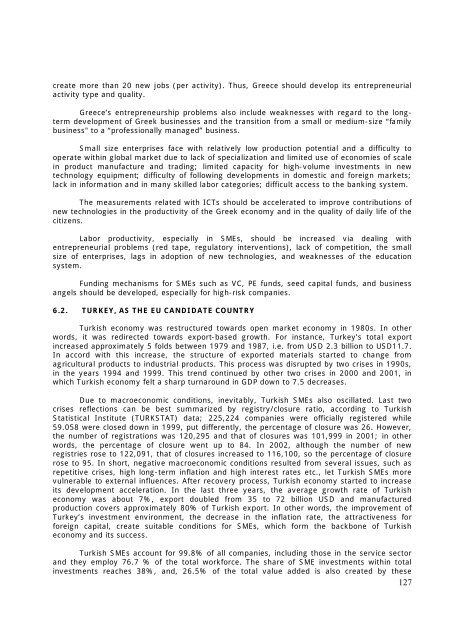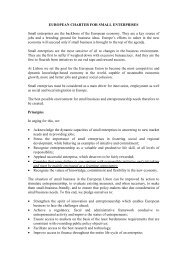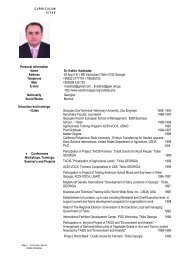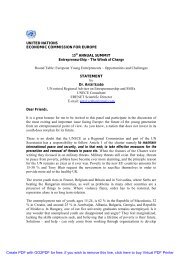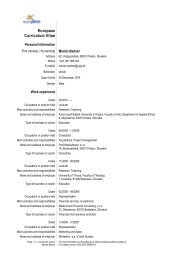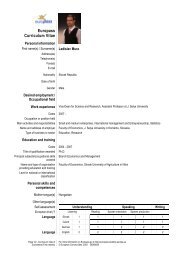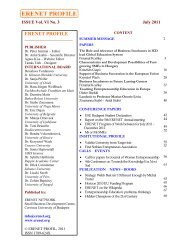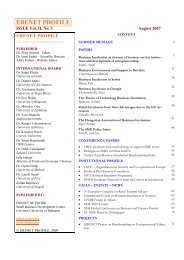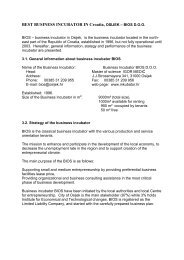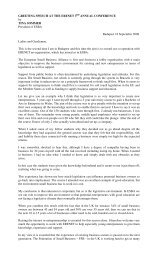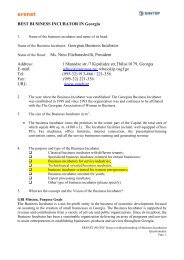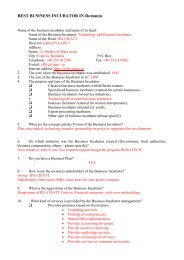In <strong>the</strong> area <strong>of</strong> bankruptcy <strong>and</strong> restructuring procedures <strong>and</strong> to promote making a freshstart, more action is needed.Greece started to receive reduced EU funding after 2006 <strong>and</strong> face intense competitionfrom EU accession countries. Therefore reforms, implemented by Greek governments, shall beaccelerated to catch-up o<strong>the</strong>r countries started much earlier if growth is to be sustainable.Creation or initiation <strong>of</strong> <strong>the</strong> so called GREEN mutual fund instrument, which helpsenterprises dealing with ecological products <strong>and</strong> policies <strong>and</strong> operations, shall be developed.In <strong>the</strong> promotion activities, all kinds <strong>of</strong> promotional tools <strong>and</strong> means that are able t<strong>of</strong>oster <strong>the</strong> international business relations, should be envisaged.The existing network schemes currently look complicated <strong>and</strong> in some cases overlappingeach o<strong>the</strong>r, <strong>and</strong> <strong>the</strong>refore, <strong>the</strong>ir role <strong>and</strong> supports for <strong>SME</strong>s are in question.Although business expenditure on R&D (BERD) is not only a way for businesses tolaunch new products <strong>and</strong> processes, measures introduced should be improved for increasingBERD <strong>and</strong> <strong>SME</strong>s innovating in-house, at least to establish a way to improve <strong>the</strong>ir absorptivecapacities <strong>and</strong> hence facilitate an effective innovation diffusion process.The greatest part <strong>of</strong> RTD activity is financed from public expenditure, whereas <strong>the</strong>business sector is lagging behind dramatically, particularly, <strong>the</strong> highest proportion <strong>of</strong> businessexpenditure on RTD comes from large <strong>and</strong> medium-sized enterprises, although <strong>the</strong>y make up asmall proportion <strong>of</strong> <strong>the</strong> total <strong>of</strong> enterprises. Therefore, Greece should not only increase its ratio<strong>of</strong> private to public expenditure but also <strong>the</strong> contribution <strong>of</strong> small sized enterprises in RTDactivities.Sufficient participation <strong>of</strong> business sector, especially <strong>SME</strong>s, in innovation governanceprocess shall be providedSimplification or unification <strong>of</strong> licensing, documents, reports, procedures, etc. wherepossible, shall be continued without lowering quality level, however, measures shall be taken toencourage related parts for changes.Regarding Broadb<strong>and</strong> Action Plan to 2008, falling prices <strong>and</strong> <strong>the</strong> initiatives taken byservice providers have led to an increase in <strong>the</strong> penetration rate from 0.47% at <strong>the</strong> end <strong>of</strong>2004 to 2.67 in June 2006, though <strong>the</strong>re is need for fur<strong>the</strong>r study in this area to providefur<strong>the</strong>r spread <strong>of</strong> broadb<strong>and</strong> in regions where citizens <strong>and</strong> businesses currently have difficultiesin gaining broadb<strong>and</strong> access.The measures aims at increasing electronic governance implementation, creating onestopshops for <strong>the</strong> better service <strong>of</strong> citizens <strong>and</strong> enterprises, as well as for <strong>the</strong> use <strong>of</strong> <strong>the</strong>internet for commercial purposes (e-commerce) should be improved.Necessity-based entrepreneurship is still high due to <strong>the</strong> long-term development <strong>of</strong>Greek businesses, ra<strong>the</strong>r than opportunity <strong>and</strong>/or corporate entrepreneurship. Greece shouldnot only develop better employment opportunities, but also create favorable conditions for <strong>the</strong>transition from a small or medium-size “family business" to a “pr<strong>of</strong>essionally managed”business.Out <strong>of</strong> all entrepreneurial endeavors made in Greece, 16.14% can be characterized ashigh-potential (contributing to market expansion, new job creation, increasing exportorientation, etc.), which means, in <strong>the</strong> following years, very few activities are expected to126
create more than 20 new jobs (per activity). Thus, Greece should develop its entrepreneurialactivity type <strong>and</strong> quality.Greece’s entrepreneurship problems also include weaknesses with regard to <strong>the</strong> longtermdevelopment <strong>of</strong> Greek businesses <strong>and</strong> <strong>the</strong> transition from a small or medium-size “familybusiness" to a “pr<strong>of</strong>essionally managed” business.Small size enterprises face with relatively low production potential <strong>and</strong> a difficulty tooperate within global market due to lack <strong>of</strong> specialization <strong>and</strong> limited use <strong>of</strong> economies <strong>of</strong> scalein product manufacture <strong>and</strong> trading; limited capacity for high-volume investments in newtechnology equipment; difficulty <strong>of</strong> following developments in domestic <strong>and</strong> foreign markets;lack in information <strong>and</strong> in many skilled labor categories; difficult access to <strong>the</strong> banking system.The measurements related with ICTs should be accelerated to improve contributions <strong>of</strong>new technologies in <strong>the</strong> productivity <strong>of</strong> <strong>the</strong> Greek economy <strong>and</strong> in <strong>the</strong> quality <strong>of</strong> daily life <strong>of</strong> <strong>the</strong>citizens.Labor productivity, especially in <strong>SME</strong>s, should be increased via dealing wi<strong>the</strong>ntrepreneurial problems (red tape, regulatory interventions), lack <strong>of</strong> competition, <strong>the</strong> smallsize <strong>of</strong> enterprises, lags in adoption <strong>of</strong> new technologies, <strong>and</strong> weaknesses <strong>of</strong> <strong>the</strong> educationsystem.Funding mechanisms for <strong>SME</strong>s such as VC, PE funds, seed capital funds, <strong>and</strong> businessangels should be developed, especially for high-risk companies.6.2. TURKEY, AS THE EU CANDIDATE COUNTRYTurkish economy was restructured towards open market economy in 1980s. In o<strong>the</strong>rwords, it was redirected towards export-based growth. For instance, Turkey’s total exportincreased approximately 5 folds between 1979 <strong>and</strong> 1987, i.e. from USD 2.3 billion to USD11.7.In accord with this increase, <strong>the</strong> structure <strong>of</strong> exported materials started to change fromagricultural products to industrial products. This process was disrupted by two crises in 1990s,in <strong>the</strong> years 1994 <strong>and</strong> 1999. This trend continued by o<strong>the</strong>r two crises in 2000 <strong>and</strong> 2001, inwhich Turkish economy felt a sharp turnaround in GDP down to 7.5 decreases.Due to macroeconomic conditions, inevitably, Turkish <strong>SME</strong>s also oscillated. Last twocrises reflections can be best summarized by registry/closure ratio, according to TurkishStatistical Institute (TURKSTAT) data; 225,224 companies were <strong>of</strong>ficially registered while59.058 were closed down in 1999, put differently, <strong>the</strong> percentage <strong>of</strong> closure was 26. However,<strong>the</strong> number <strong>of</strong> registrations was 120,295 <strong>and</strong> that <strong>of</strong> closures was 101,999 in 2001; in o<strong>the</strong>rwords, <strong>the</strong> percentage <strong>of</strong> closure went up to 84. In 2002, although <strong>the</strong> number <strong>of</strong> newregistries rose to 122,091, that <strong>of</strong> closures increased to 116,100, so <strong>the</strong> percentage <strong>of</strong> closurerose to 95. In short, negative macroeconomic conditions resulted from several issues, such asrepetitive crises, high long-term inflation <strong>and</strong> high interest rates etc., let Turkish <strong>SME</strong>s morevulnerable to external influences. After recovery process, Turkish economy started to increaseits development acceleration. In <strong>the</strong> last three years, <strong>the</strong> average growth rate <strong>of</strong> Turkisheconomy was about 7%, export doubled from 35 to 72 billion USD <strong>and</strong> manufacturedproduction covers approximately 80% <strong>of</strong> Turkish export. In o<strong>the</strong>r words, <strong>the</strong> improvement <strong>of</strong>Turkey’s investment environment, <strong>the</strong> decrease in <strong>the</strong> inflation rate, <strong>the</strong> attractiveness forforeign capital, create suitable conditions for <strong>SME</strong>s, which form <strong>the</strong> backbone <strong>of</strong> Turkisheconomy <strong>and</strong> its success.Turkish <strong>SME</strong>s account for 99.8% <strong>of</strong> all companies, including those in <strong>the</strong> service sector<strong>and</strong> <strong>the</strong>y employ 76.7 % <strong>of</strong> <strong>the</strong> total workforce. The share <strong>of</strong> <strong>SME</strong> investments within totalinvestments reaches 38%, <strong>and</strong>, 26.5% <strong>of</strong> <strong>the</strong> total value added is also created by <strong>the</strong>se127
- Page 4 and 5:
1. SME DECLARATION AND WORKING GROU
- Page 6 and 7:
While comparing the BSEC and EU doc
- Page 8 and 9:
cooperation with the United Nations
- Page 10 and 11:
GENERAL ASSESSMENT OF THE BSEC WG O
- Page 12 and 13:
“Armenia's new law introduces a n
- Page 14 and 15:
(iii)Share of the labor force of SM
- Page 16 and 17:
The following data represents some
- Page 18 and 19:
RankDocuments for export(number)Tra
- Page 20 and 21:
• Industrial zones/Business incub
- Page 22 and 23:
3.1.4. FINANCING SMEsProf. Dr. Sela
- Page 24 and 25:
• the loan is secured with movabl
- Page 26 and 27:
3.1.4.3. Mutual and loan guarantee
- Page 28 and 29:
introduction of e-signatures, only
- Page 30 and 31:
The Code of Conduct for Civil Serva
- Page 32 and 33:
Trading Across Borders Enforcing Co
- Page 34 and 35:
as with all non-governmental organi
- Page 36 and 37:
Bulgarian SMEs obtain additional ca
- Page 38 and 39:
• Project BG 2004/016-711.11.04 -
- Page 40 and 41:
usiness is not approaching them oft
- Page 42 and 43:
• Romanian citizens are recognize
- Page 44 and 45:
The preparatory project of the NDP
- Page 46 and 47:
• To support participation in eco
- Page 48 and 49:
In 2004, the National Institute of
- Page 50 and 51:
Incubators host on average 11 SME,
- Page 52 and 53:
Programs. The program is implemente
- Page 54 and 55:
development instrument is extremely
- Page 56 and 57:
accounting standards, including med
- Page 58 and 59:
corporations and open held corporat
- Page 60 and 61:
promoting SME sector, cooperation w
- Page 62 and 63:
• for unemployed (micro credit)
- Page 64 and 65:
are private pension funds, broker h
- Page 66 and 67:
very early steps of its democratic
- Page 68 and 69:
Another negative factor that is mor
- Page 70 and 71:
economy. The so called in the organ
- Page 72 and 73:
Federal funds, private capital, esp
- Page 74 and 75:
4.3. MOLDOVATable 14.Dimensions Neg
- Page 76 and 77: Related andsupportingindustriesDome
- Page 78 and 79: Technological:Internetaccessibility
- Page 80 and 81: Domesticdemand• Still not many pe
- Page 82 and 83: international investments• Govern
- Page 84 and 85: 3. Hamel, G., Prahalad, C.K. (1994)
- Page 86 and 87: 5.2 DEVELOPMENT OF THE SME SECTOR I
- Page 88 and 89: General Characteristic of SME Devel
- Page 90 and 91: Index of SME Development in Armenia
- Page 92 and 93: The same problem exists in getting
- Page 94 and 95: SME support infrastructure in Armen
- Page 96 and 97: 5 million was provided by UNDP and
- Page 98 and 99: 5.3 DEVELOPMENT OF THE SME SECTOR I
- Page 100 and 101: Diagram 1. The number of small ente
- Page 102 and 103: The privatization process of object
- Page 104 and 105: 13.Cabinet Provision on “Distribu
- Page 106 and 107: 5.3.3. SME support infrastructure i
- Page 108 and 109: The role of the state in technical
- Page 110 and 111: General situation of credit marketT
- Page 112 and 113: After creation and starting impleme
- Page 114 and 115: At the meantime, small enterprise s
- Page 116 and 117: Table. 32.Ease of businessDoingBusi
- Page 118 and 119: people who start small businesses t
- Page 120 and 121: are salaried and the medium - sized
- Page 122 and 123: Technology Foresight in Greece 2001
- Page 124 and 125: Greek VC market started to develop
- Page 128 and 129: enterprises. According to TURKSTAT,
- Page 130 and 131: small size enterprise or micro ente
- Page 132 and 133: industrial enterprises. Undersecret
- Page 134 and 135: individuals, rather than well struc
- Page 136 and 137: 7. SUGGESTIONS FOR THE SME DEVELOPM
- Page 138 and 139: Annex 1.MAP OF THE BLACK SEA COUNTR
- Page 140 and 141: 17-18 June 2005 1 st Moscow Interna
- Page 142 and 143: ARMENIASTRENGTHS• Application of
- Page 144 and 145: BULGARIASTRENGHT• Flexibility and
- Page 146 and 147: GREECESTRENGHT• They have a vital
- Page 148 and 149: ROMANIASTRENGHTWEAKNESS• Stabilis
- Page 150 and 151: REPUBLIC OF SERBIASTRENGHT• Longe
- Page 152 and 153: UKRAINESTRENGTHS• Well educated l
- Page 154 and 155: In compliance with the Resolution m
- Page 156 and 157: 1. Please provide definition of SME
- Page 158 and 159: 7. Did you establish a dedicated bo
- Page 160: 11. Do you have any suggestions for


